Full text
PDF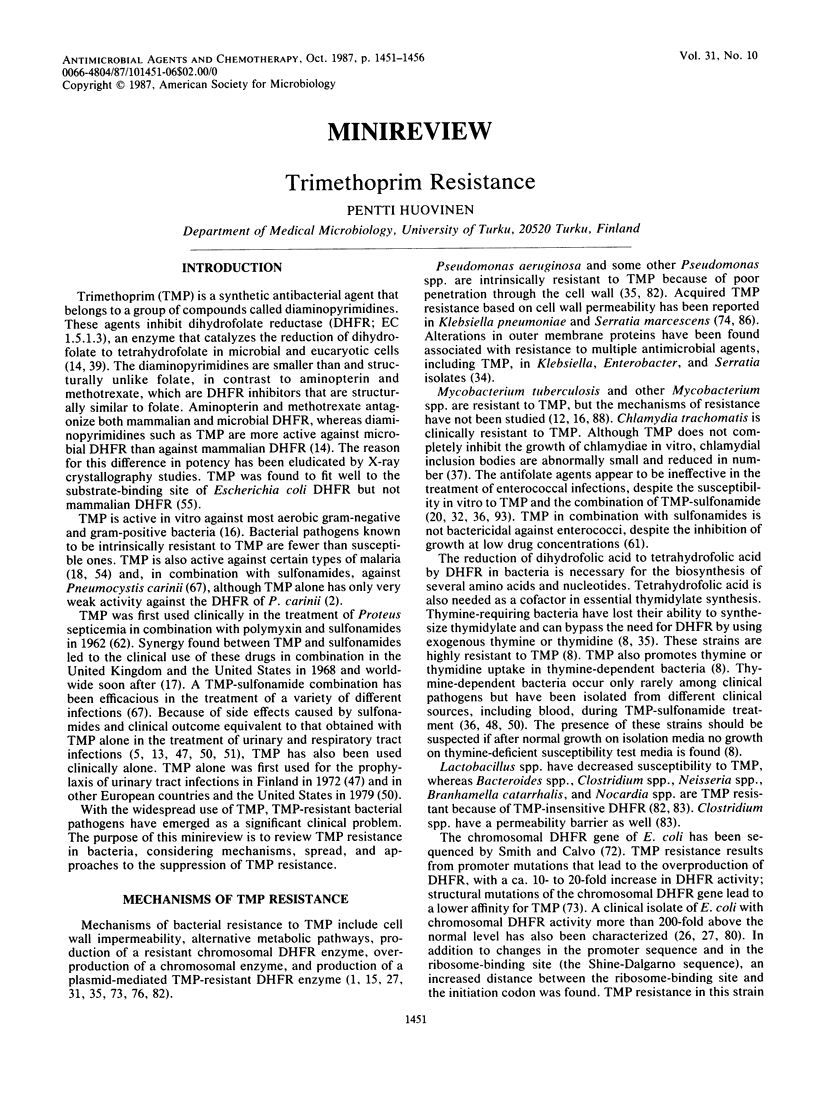
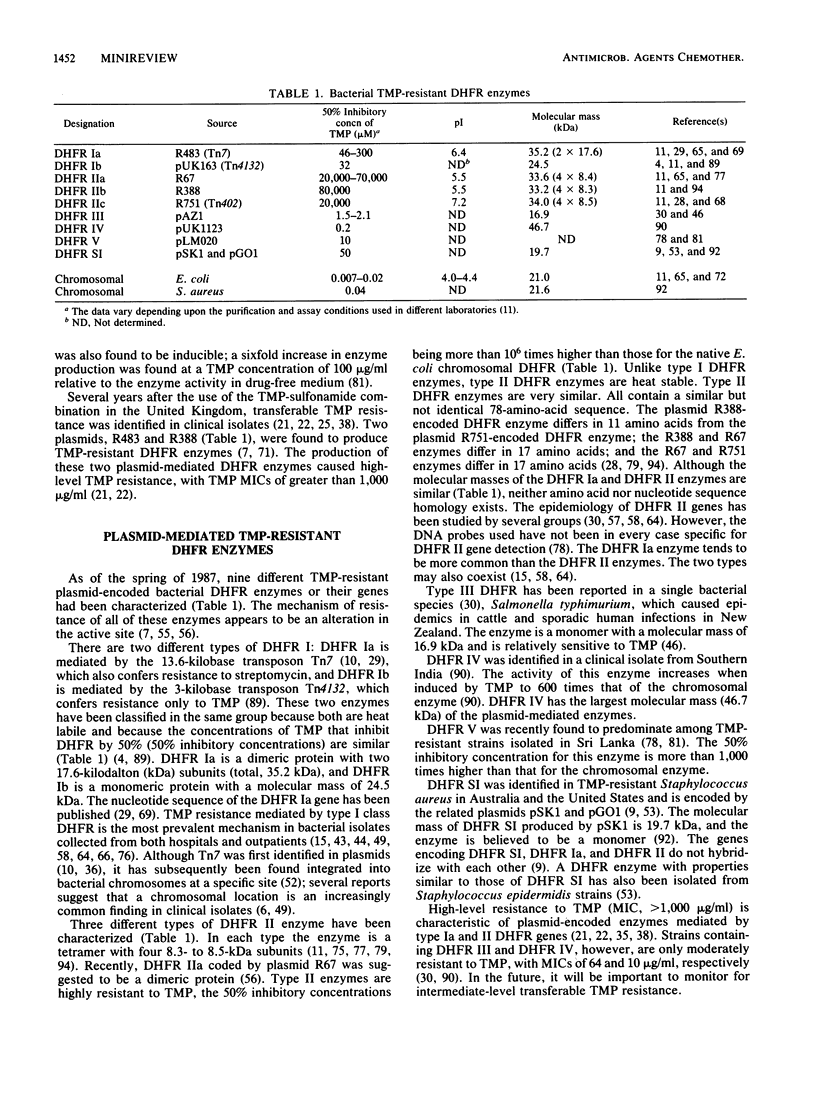
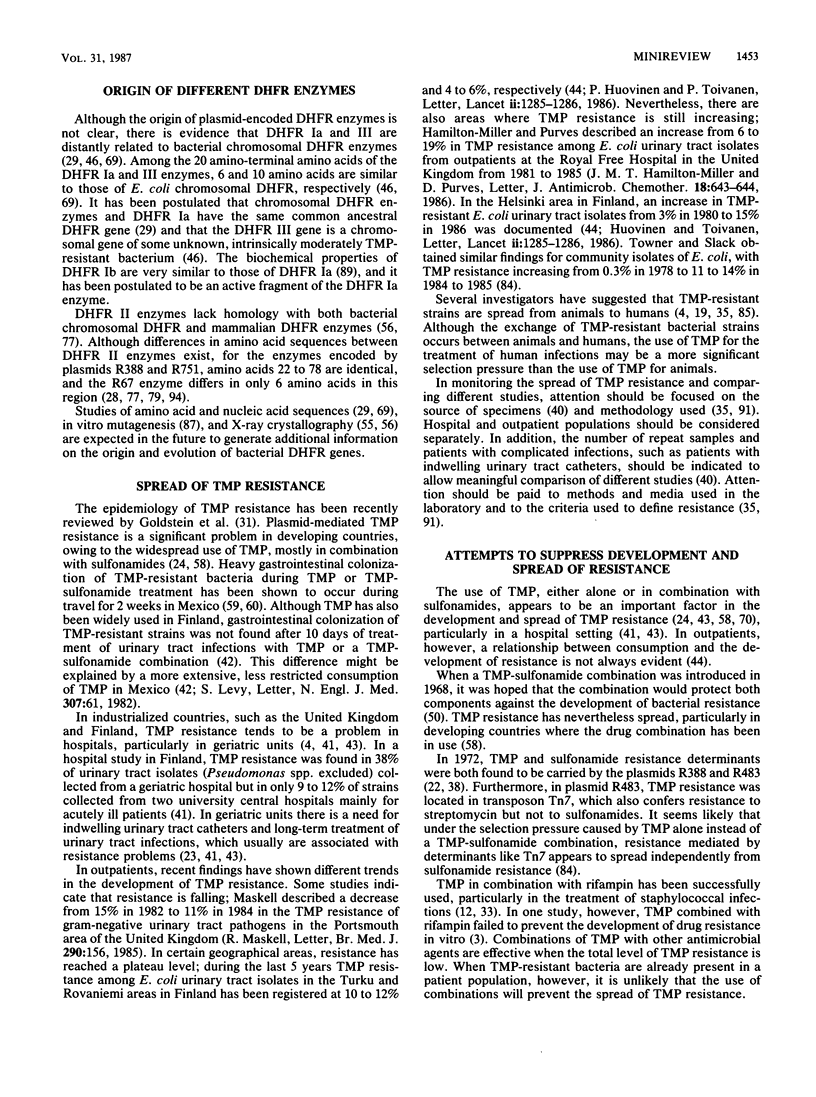
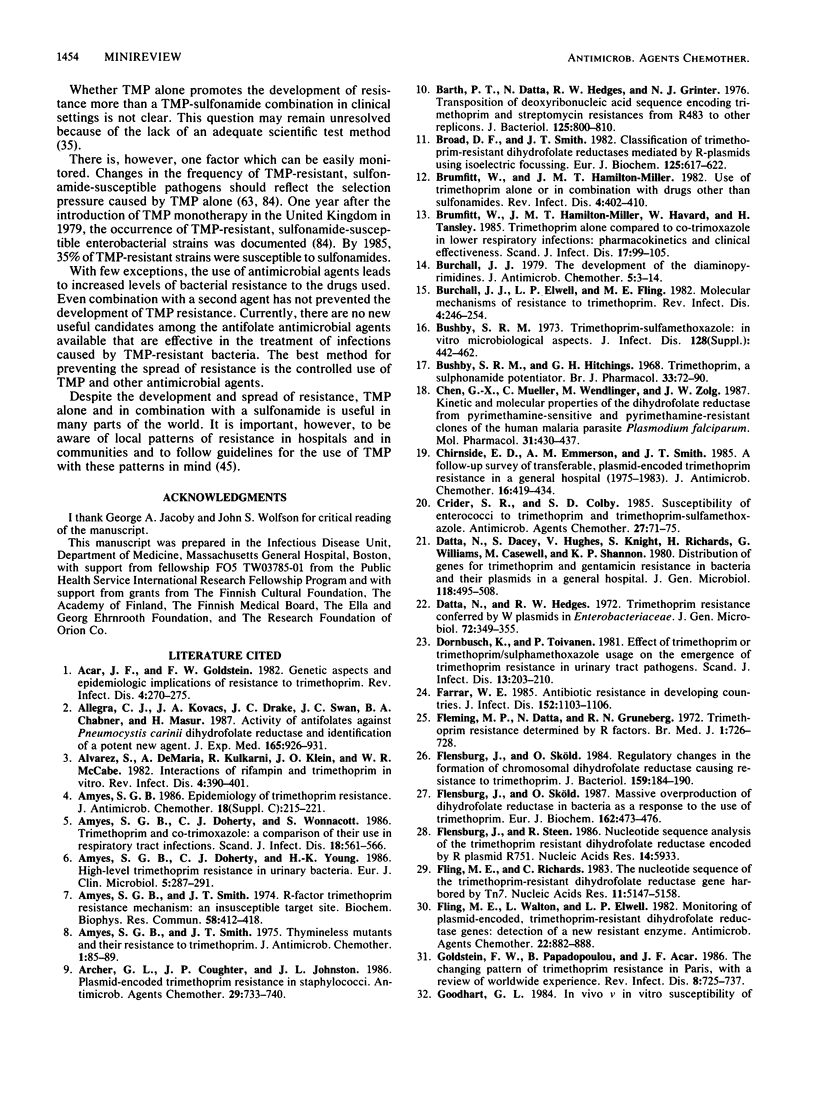
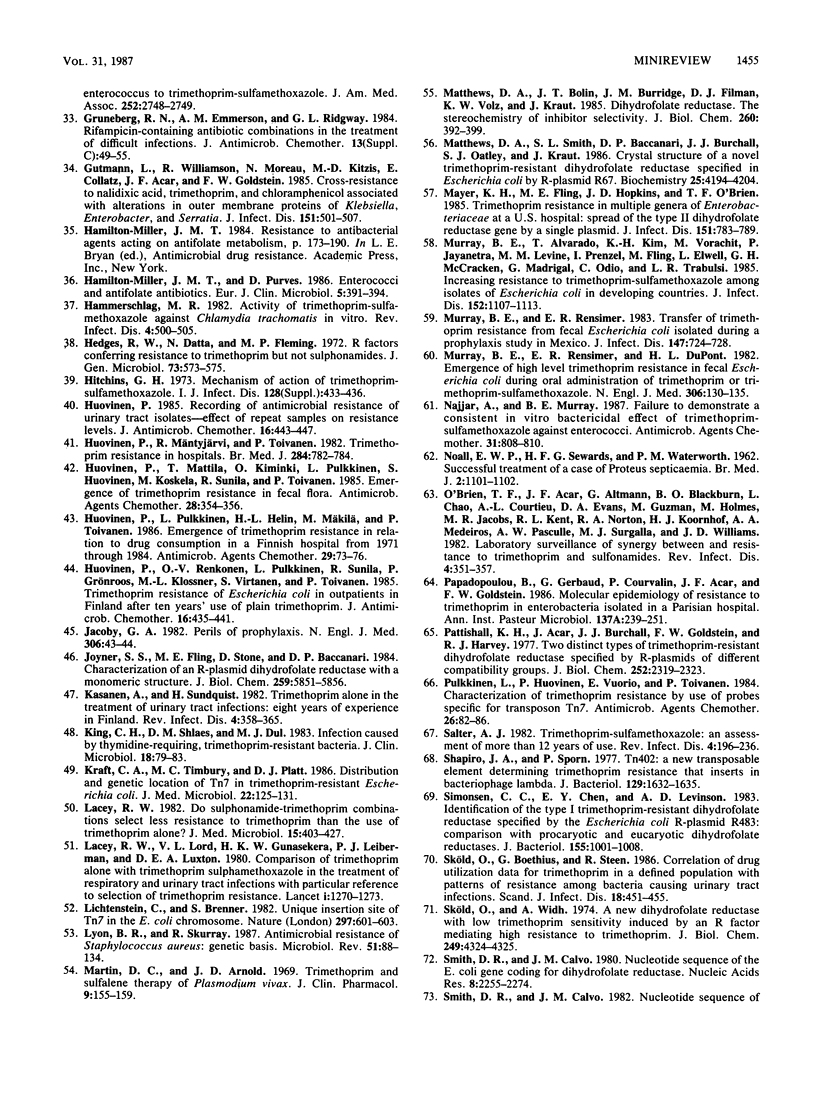
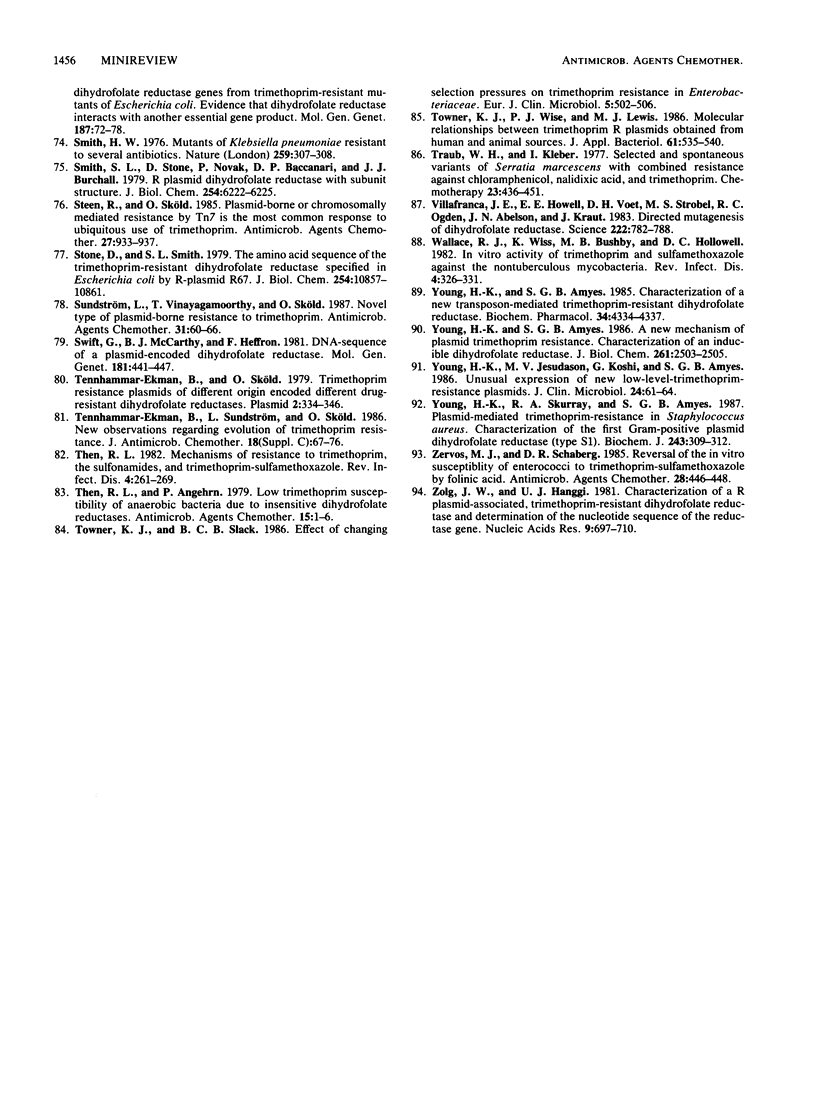
Selected References
These references are in PubMed. This may not be the complete list of references from this article.
- Acar J. F., Goldstein F. W. Genetic aspects and epidemiologic implications of resistance to trimethoprim. Rev Infect Dis. 1982 Mar-Apr;4(2):270–275. doi: 10.1093/clinids/4.2.270. [DOI] [PubMed] [Google Scholar]
- Allegra C. J., Kovacs J. A., Drake J. C., Swan J. C., Chabner B. A., Masur H. Activity of antifolates against Pneumocystis carinii dihydrofolate reductase and identification of a potent new agent. J Exp Med. 1987 Mar 1;165(3):926–931. doi: 10.1084/jem.165.3.926. [DOI] [PMC free article] [PubMed] [Google Scholar]
- Alvarez S., DeMaria A., Jr, Kulkarni R., Klein J. O., McCabe W. R. Interactions of rifampin and trimethoprim in vitro. Rev Infect Dis. 1982 Mar-Apr;4(2):390–401. doi: 10.1093/clinids/4.2.390. [DOI] [PubMed] [Google Scholar]
- Amyes S. G., Doherty C. J., Wonnacott S. Trimethoprim and co-trimoxazole: a comparison of their use in respiratory tract infections. Scand J Infect Dis. 1986;18(6):561–566. doi: 10.3109/00365548609021663. [DOI] [PubMed] [Google Scholar]
- Amyes S. G., Doherty C. J., Young H. K. High-level trimethoprim resistance in urinary bacteria. Eur J Clin Microbiol. 1986 Jun;5(3):287–291. doi: 10.1007/BF02017783. [DOI] [PubMed] [Google Scholar]
- Amyes S. G. Epidemiology of trimethoprim resistance. J Antimicrob Chemother. 1986 Oct;18 (Suppl 100):215–221. doi: 10.1093/jac/18.supplement_c.215. [DOI] [PubMed] [Google Scholar]
- Amyes S. G., Smith J. T. R-factor trimethoprim resistance mechanism: an insusceptible target site. Biochem Biophys Res Commun. 1974 May 20;58(2):412–418. doi: 10.1016/0006-291x(74)90380-5. [DOI] [PubMed] [Google Scholar]
- Amyes S. G., Smith J. T. Thymineless mutants and their resistance to trimethoprim. J Antimicrob Chemother. 1975 Mar;1(1):85–89. doi: 10.1093/jac/1.1.85. [DOI] [PubMed] [Google Scholar]
- Archer G. L., Coughter J. P., Johnston J. L. Plasmid-encoded trimethoprim resistance in staphylococci. Antimicrob Agents Chemother. 1986 May;29(5):733–740. doi: 10.1128/aac.29.5.733. [DOI] [PMC free article] [PubMed] [Google Scholar]
- Barth P. T., Datta N., Hedges R. W., Grinter N. J. Transposition of a deoxyribonucleic acid sequence encoding trimethoprim and streptomycin resistances from R483 to other replicons. J Bacteriol. 1976 Mar;125(3):800–810. doi: 10.1128/jb.125.3.800-810.1976. [DOI] [PMC free article] [PubMed] [Google Scholar]
- Broad D. F., Smith J. T. Classification of trimethoprim-resistant dihydrofolate reductases mediated by R-plasmids using isoelectric focussing. Eur J Biochem. 1982 Jul;125(3):617–622. doi: 10.1111/j.1432-1033.1982.tb06727.x. [DOI] [PubMed] [Google Scholar]
- Brumfitt W., Hamilton-Miller J. M., Havard C. W., Tansley H. Trimethoprim alone compared to co-trimoxazole in lower respiratory infections: pharmacokinetics and clinical effectiveness. Scand J Infect Dis. 1985;17(1):99–105. doi: 10.3109/00365548509070428. [DOI] [PubMed] [Google Scholar]
- Brumfitt W., Hamilton-Miller J. M. Use of trimethoprim alone or in combination with drugs other than sulfonamides. Rev Infect Dis. 1982 Mar-Apr;4(2):402–410. doi: 10.1093/clinids/4.2.402. [DOI] [PubMed] [Google Scholar]
- Burchall J. J., Elwell L. P., Fling M. E. Molecular mechanisms of resistance to trimethoprim. Rev Infect Dis. 1982 Mar-Apr;4(2):246–254. doi: 10.1093/clinids/4.2.246. [DOI] [PubMed] [Google Scholar]
- Burchall J. J. The development of the diaminopyrimidines. J Antimicrob Chemother. 1979 Nov;5(B):3–14. doi: 10.1093/jac/5.supplement_b.3. [DOI] [PubMed] [Google Scholar]
- Bushby S. R., Hitchings G. H. Trimethoprim, a sulphonamide potentiator. Br J Pharmacol Chemother. 1968 May;33(1):72–90. doi: 10.1111/j.1476-5381.1968.tb00475.x. [DOI] [PMC free article] [PubMed] [Google Scholar]
- Bushby S. R. Trimethoprim-sulfamethoxazole: in vitro microbiological aspects. J Infect Dis. 1973 Nov;128(Suppl):442–p. doi: 10.1093/infdis/128.supplement_3.s442. [DOI] [PubMed] [Google Scholar]
- Chen G. X., Mueller C., Wendlinger M., Zolg J. W. Kinetic and molecular properties of the dihydrofolate reductase from pyrimethamine-sensitive and pyrimethamine-resistant clones of the human malaria parasite Plasmodium falciparum. Mol Pharmacol. 1987 Apr;31(4):430–437. [PubMed] [Google Scholar]
- Chirnside E. D., Emmerson A. M., Smith J. T. A follow-up survey of transferable, plasmid-encoded trimethoprim resistance in a general hospital (1975-1983). J Antimicrob Chemother. 1985 Oct;16(4):419–434. doi: 10.1093/jac/16.4.419. [DOI] [PubMed] [Google Scholar]
- Crider S. R., Colby S. D. Susceptibility of enterococci to trimethoprim and trimethoprim-sulfamethoxazole. Antimicrob Agents Chemother. 1985 Jan;27(1):71–75. doi: 10.1128/aac.27.1.71. [DOI] [PMC free article] [PubMed] [Google Scholar]
- Datta N., Dacey S., Hughes V., Knight S., Richards H., Williams G., Casewell M., Shannon K. P. Distribution of genes for trimethoprim and gentamicin resistance in bacteria and their plasmids in a general hospital. J Gen Microbiol. 1980 Jun;118(2):495–508. doi: 10.1099/00221287-118-2-495. [DOI] [PubMed] [Google Scholar]
- Datta N., Hedges R. W. Trimethoprim resistance conferred by W plasmids in Enterobacteriaceae. J Gen Microbiol. 1972 Sep;72(2):349–355. doi: 10.1099/00221287-72-2-349. [DOI] [PubMed] [Google Scholar]
- Dornbusch K., Toivanen P. Effect of trimethoprim or trimethoprim/sulphamethoxazole usage on the emergence of trimethoprim resistance in urinary tract pathogens. Scand J Infect Dis. 1981;13(3):203–210. doi: 10.3109/inf.1981.13.issue-3.08. [DOI] [PubMed] [Google Scholar]
- Farrar W. E. Antibiotic resistance in developing countries. J Infect Dis. 1985 Dec;152(6):1103–1106. doi: 10.1093/infdis/152.6.1103. [DOI] [PubMed] [Google Scholar]
- Fleming M. P., Datta N., Grüneberg R. N. Trimethoprim resistance determined by R factors. Br Med J. 1972 Mar 18;1(5802):726–728. doi: 10.1136/bmj.1.5802.726. [DOI] [PMC free article] [PubMed] [Google Scholar]
- Flensburg J., Sköld O. Massive overproduction of dihydrofolate reductase in bacteria as a response to the use of trimethoprim. Eur J Biochem. 1987 Feb 2;162(3):473–476. doi: 10.1111/j.1432-1033.1987.tb10664.x. [DOI] [PubMed] [Google Scholar]
- Flensburg J., Sköld O. Regulatory changes in the formation of chromosomal dihydrofolate reductase causing resistance to trimethoprim. J Bacteriol. 1984 Jul;159(1):184–190. doi: 10.1128/jb.159.1.184-190.1984. [DOI] [PMC free article] [PubMed] [Google Scholar]
- Flensburg J., Steen R. Nucleotide sequence analysis of the trimethoprim resistant dihydrofolate reductase encoded by R plasmid R751. Nucleic Acids Res. 1986 Jul 25;14(14):5933–5933. doi: 10.1093/nar/14.14.5933. [DOI] [PMC free article] [PubMed] [Google Scholar]
- Fling M. E., Richards C. The nucleotide sequence of the trimethoprim-resistant dihydrofolate reductase gene harbored by Tn7. Nucleic Acids Res. 1983 Aug 11;11(15):5147–5158. doi: 10.1093/nar/11.15.5147. [DOI] [PMC free article] [PubMed] [Google Scholar]
- Fling M. E., Walton L., Elwell L. P. Monitoring of plasmid-encoded, trimethoprim-resistant dihydrofolate reductase genes: detection of a new resistant enzyme. Antimicrob Agents Chemother. 1982 Nov;22(5):882–888. doi: 10.1128/aac.22.5.882. [DOI] [PMC free article] [PubMed] [Google Scholar]
- Goldstein F. W., Papadopoulou B., Acar J. F. The changing pattern of trimethoprim resistance in Paris, with a review of worldwide experience. Rev Infect Dis. 1986 Sep-Oct;8(5):725–737. doi: 10.1093/clinids/8.5.725. [DOI] [PubMed] [Google Scholar]
- Goodhart G. L. In vivo v in vitro susceptibility of enterococcus to trimethoprim-sulfamethoxazole. A pitfall. JAMA. 1984 Nov 16;252(19):2748–2749. [PubMed] [Google Scholar]
- Grüneberg R. N., Emmerson A. M., Ridgway G. L. Rifampicin-containing antibiotic combinations in the treatment of difficult infections. J Antimicrob Chemother. 1984 Jun;13 (Suppl 100):49–55. doi: 10.1093/jac/13.suppl_c.49. [DOI] [PubMed] [Google Scholar]
- Gutmann L., Williamson R., Moreau N., Kitzis M. D., Collatz E., Acar J. F., Goldstein F. W. Cross-resistance to nalidixic acid, trimethoprim, and chloramphenicol associated with alterations in outer membrane proteins of Klebsiella, Enterobacter, and Serratia. J Infect Dis. 1985 Mar;151(3):501–507. doi: 10.1093/infdis/151.3.501. [DOI] [PubMed] [Google Scholar]
- Hamilton-Miller J. M., Purves D. Enterococci and antifolate antibiotics. Eur J Clin Microbiol. 1986 Aug;5(4):391–394. [PubMed] [Google Scholar]
- Hammerschlag M. R. Activity of trimethoprim-sulfamethoxazole against Chlamydia trachomatis in vitro. Rev Infect Dis. 1982 Mar-Apr;4(2):500–505. doi: 10.1093/clinids/4.2.500. [DOI] [PubMed] [Google Scholar]
- Hedges R. W., Datta N., Fleming M. P. R factors conferring resistance to trimethoprim but not sulphonamides. J Gen Microbiol. 1972 Dec;73(3):573–575. doi: 10.1099/00221287-73-3-573. [DOI] [PubMed] [Google Scholar]
- Hitchings G. H. Mechanism of action of trimethoprim-sulfamethoxazole. I. J Infect Dis. 1973 Nov;128(Suppl):433–p. doi: 10.1093/infdis/128.supplement_3.s433. [DOI] [PubMed] [Google Scholar]
- Huovinen P., Mattila T., Kiminki O., Pulkkinen L., Huovinen S., Koskela M., Sunila R., Toivanen P. Emergence of trimethoprim resistance in fecal flora. Antimicrob Agents Chemother. 1985 Aug;28(2):354–356. doi: 10.1128/aac.28.2.354. [DOI] [PMC free article] [PubMed] [Google Scholar]
- Huovinen P., Mäntyjärvi R., Toivanen P. Trimethoprim resistance in hospitals. Br Med J (Clin Res Ed) 1982 Mar 13;284(6318):782–784. doi: 10.1136/bmj.284.6318.782. [DOI] [PMC free article] [PubMed] [Google Scholar]
- Huovinen P., Pulkkinen L., Helin H. L., Mäkilä M., Toivanen P. Emergence of trimethoprim resistance in relation to drug consumption in a Finnish hospital from 1971 through 1984. Antimicrob Agents Chemother. 1986 Jan;29(1):73–76. doi: 10.1128/aac.29.1.73. [DOI] [PMC free article] [PubMed] [Google Scholar]
- Huovinen P. Recording of antimicrobial resistance of urinary tract isolates--effect of repeat samples on resistance levels. J Antimicrob Chemother. 1985 Oct;16(4):443–447. doi: 10.1093/jac/16.4.443. [DOI] [PubMed] [Google Scholar]
- Huovinen P., Renkonen O. V., Pulkkinen L., Sunila R., Grönroos P., Klossner M. L., Virtanen S., Toivanen P. Trimethoprim resistance of Escherichia coli in outpatients in Finland after ten years' use of plain trimethoprim. J Antimicrob Chemother. 1985 Oct;16(4):435–441. doi: 10.1093/jac/16.4.435. [DOI] [PubMed] [Google Scholar]
- Jacoby G. A. Perils of prophylaxis. N Engl J Med. 1982 Jan 7;306(1):43–44. doi: 10.1056/NEJM198201073060111. [DOI] [PubMed] [Google Scholar]
- Joyner S. S., Fling M. E., Stone D., Baccanari D. P. Characterization of an R-plasmid dihydrofolate reductase with a monomeric structure. J Biol Chem. 1984 May 10;259(9):5851–5856. [PubMed] [Google Scholar]
- Kasanen A., Sundquist H. Trimethoprim alone in the treatment of urinary tract infections: eight years of experience in Finland. Rev Infect Dis. 1982 Mar-Apr;4(2):358–365. doi: 10.1093/clinids/4.2.358. [DOI] [PubMed] [Google Scholar]
- King C. H., Shlaes D. M., Dul M. J. Infection caused by thymidine-requiring, trimethoprim-resistant bacteria. J Clin Microbiol. 1983 Jul;18(1):79–83. doi: 10.1128/jcm.18.1.79-83.1983. [DOI] [PMC free article] [PubMed] [Google Scholar]
- Kraft C. A., Timbury M. C., Platt D. J. Distribution and genetic location of Tn7 in trimethoprim-resistant Escherichia coli. J Med Microbiol. 1986 Sep;22(2):125–131. doi: 10.1099/00222615-22-2-125. [DOI] [PubMed] [Google Scholar]
- Lacey R. W. Do sulphonamide-trimethoprim combinations select less resistance to trimethoprim than the use of trimethoprim alone? J Med Microbiol. 1982 Nov;15(4):403–427. doi: 10.1099/00222615-15-4-403. [DOI] [PubMed] [Google Scholar]
- Lacey R. W., Lord V. L., Gunasekera H. K., Leiberman P. J., Luxton D. E. Comparison of trimethoprim alone with trimethoprim sulphamethoxazole in the treatment of respiratory and urinary infections with particular reference to selection of trimethoprim resistance. Lancet. 1980 Jun 14;1(8181):1270–1273. doi: 10.1016/s0140-6736(80)91732-8. [DOI] [PubMed] [Google Scholar]
- Lichtenstein C., Brenner S. Unique insertion site of Tn7 in the E. coli chromosome. Nature. 1982 Jun 17;297(5867):601–603. doi: 10.1038/297601a0. [DOI] [PubMed] [Google Scholar]
- Lyon B. R., Skurray R. Antimicrobial resistance of Staphylococcus aureus: genetic basis. Microbiol Rev. 1987 Mar;51(1):88–134. doi: 10.1128/mr.51.1.88-134.1987. [DOI] [PMC free article] [PubMed] [Google Scholar]
- Martin D. C., Arnold J. D. Trimethroprim and sulfalene therapy of Plasmodium vivax. J Clin Pharmacol J New Drugs. 1969 May-Jun;9(3):155–159. [PubMed] [Google Scholar]
- Matthews D. A., Bolin J. T., Burridge J. M., Filman D. J., Volz K. W., Kraut J. Dihydrofolate reductase. The stereochemistry of inhibitor selectivity. J Biol Chem. 1985 Jan 10;260(1):392–399. [PubMed] [Google Scholar]
- Matthews D. A., Smith S. L., Baccanari D. P., Burchall J. J., Oatley S. J., Kraut J. Crystal structure of a novel trimethoprim-resistant dihydrofolate reductase specified in Escherichia coli by R-plasmid R67. Biochemistry. 1986 Jul 29;25(15):4194–4204. doi: 10.1021/bi00363a005. [DOI] [PubMed] [Google Scholar]
- Mayer K. H., Fling M. E., Hopkins J. D., O'Brien T. F. Trimethoprim resistance in multiple genera of Enterobacteriaceae at a U.S. hospital: spread of the type II dihydrofolate reductase gene by a single plasmid. J Infect Dis. 1985 May;151(5):783–789. doi: 10.1093/infdis/151.5.783. [DOI] [PubMed] [Google Scholar]
- Murray B. E., Alvarado T., Kim K. H., Vorachit M., Jayanetra P., Levine M. M., Prenzel I., Fling M., Elwell L., McCracken G. H. Increasing resistance to trimethoprim-sulfamethoxazole among isolates of Escherichia coli in developing countries. J Infect Dis. 1985 Dec;152(6):1107–1113. doi: 10.1093/infdis/152.6.1107. [DOI] [PubMed] [Google Scholar]
- Murray B. E., Rensimer E. R., DuPont H. L. Emergence of high-level trimethoprim resistance in fecal Escherichia coli during oral administration of trimethoprim or trimethoprim--sulfamethoxazole. N Engl J Med. 1982 Jan 21;306(3):130–135. doi: 10.1056/NEJM198201213060302. [DOI] [PubMed] [Google Scholar]
- Murray B. E., Rensimer E. R. Transfer of trimethoprim resistance from fecal Escherichia coli isolated during a prophylaxis study in Mexico. J Infect Dis. 1983 Apr;147(4):724–728. doi: 10.1093/infdis/147.4.724. [DOI] [PubMed] [Google Scholar]
- Najjar A., Murray B. E. Failure to demonstrate a consistent in vitro bactericidal effect of trimethoprim-sulfamethoxazole against enterococci. Antimicrob Agents Chemother. 1987 May;31(5):808–810. doi: 10.1128/aac.31.5.808. [DOI] [PMC free article] [PubMed] [Google Scholar]
- Noall E. W., Sewards H. F., Waterworth P. M. Successful Treatment of a Case of Proteus Septicaemia. Br Med J. 1962 Oct 27;2(5312):1101–1102. doi: 10.1136/bmj.2.5312.1101. [DOI] [PMC free article] [PubMed] [Google Scholar]
- O'Brien T. F., Acar J. F., Altmann G., Blackburn B. O., Chao L., Courtieu A. L., Evans D. A., Guzman M., Holmes M., Jacobs M. R. Laboratory surveillance of synergy between and resistance to trimethoprim and sulfonamides. Rev Infect Dis. 1982 Mar-Apr;4(2):351–357. doi: 10.1093/clinids/4.2.351. [DOI] [PubMed] [Google Scholar]
- Papadopoulou B., Gerbaud G., Courvalin P., Acar J. F., Goldstein F. W. Molecular epidemiology of resistance to trimethoprim in enterobacteria isolated in a Parisian hospital. Ann Inst Pasteur Microbiol. 1986 May-Jun;137A(3):239–251. doi: 10.1016/s0769-2609(86)80031-x. [DOI] [PubMed] [Google Scholar]
- Pattishall K. H., Acar J., Burchall J. J., Goldstein F. W., Harvey R. J. Two distinct types of trimethoprim-resistant dihydrofolate reductase specified by R-plasmids of different compatibility groups. J Biol Chem. 1977 Apr 10;252(7):2319–2323. [PubMed] [Google Scholar]
- Pulkkinen L., Huovinen P., Vuorio E., Toivanen P. Characterization of trimethoprim resistance by use of probes specific for transposon Tn7. Antimicrob Agents Chemother. 1984 Jul;26(1):82–86. doi: 10.1128/aac.26.1.82. [DOI] [PMC free article] [PubMed] [Google Scholar]
- Salter A. J. Trimethoprim-sulfamethoxazole: an assessment of more than 12 years of use. Rev Infect Dis. 1982 Mar-Apr;4(2):196–236. doi: 10.1093/clinids/4.2.196. [DOI] [PubMed] [Google Scholar]
- Shapiro J. A., Sporn P. Tn402: a new transposable element determining trimethoprim resistance that inserts in bacteriophage lambda. J Bacteriol. 1977 Mar;129(3):1632–1635. doi: 10.1128/jb.129.3.1632-1635.1977. [DOI] [PMC free article] [PubMed] [Google Scholar]
- Simonsen C. C., Chen E. Y., Levinson A. D. Identification of the type I trimethoprim-resistant dihydrofolate reductase specified by the Escherichia coli R-plasmid R483: comparison with procaryotic and eucaryotic dihydrofolate reductases. J Bacteriol. 1983 Sep;155(3):1001–1008. doi: 10.1128/jb.155.3.1001-1008.1983. [DOI] [PMC free article] [PubMed] [Google Scholar]
- Sköld O., Boethius G., Steen R. Correlation of drug utilization data for trimethoprim in a defined population with patterns of resistance among bacteria causing urinary tract infections. Scand J Infect Dis. 1986;18(5):451–455. doi: 10.3109/00365548609032363. [DOI] [PubMed] [Google Scholar]
- Sköld O., Widh A. A new dihydrofolate reductase with low trimethoprim sensitivity induced by an R factor mediating high resistance to trimethoprim. J Biol Chem. 1974 Jul 10;249(13):4324–4325. [PubMed] [Google Scholar]
- Smith D. R., Calvo J. M. Nucleotide sequence of the E coli gene coding for dihydrofolate reductase. Nucleic Acids Res. 1980 May 24;8(10):2255–2274. doi: 10.1093/nar/8.10.2255. [DOI] [PMC free article] [PubMed] [Google Scholar]
- Smith H. W. Mutants of Klebsiella pneumoniae resistant to several antibiotics. Nature. 1976 Jan 29;259(5541):307–308. doi: 10.1038/259307a0. [DOI] [PubMed] [Google Scholar]
- Smith S. L., Stone D., Novak P., Baccanari D. P., Burchall J. J. R plasmid dihydrofolate reductase with subunit structure. J Biol Chem. 1979 Jul 25;254(14):6222–6225. [PubMed] [Google Scholar]
- Steen R., Sköld O. Plasmid-borne or chromosomally mediated resistance by Tn7 is the most common response to ubiquitous use of trimethoprim. Antimicrob Agents Chemother. 1985 Jun;27(6):933–937. doi: 10.1128/aac.27.6.933. [DOI] [PMC free article] [PubMed] [Google Scholar]
- Stone D., Smith S. L. The amino acid sequence of the trimethoprim-resistant dihydrofolate reductase specified in Escherichia coli by R-plasmid R67. J Biol Chem. 1979 Nov 10;254(21):10857–10861. [PubMed] [Google Scholar]
- Sundström L., Vinayagamoorthy T., Sköld O. Novel type of plasmid-borne resistance to trimethoprim. Antimicrob Agents Chemother. 1987 Jan;31(1):60–66. doi: 10.1128/aac.31.1.60. [DOI] [PMC free article] [PubMed] [Google Scholar]
- Swift G., McCarthy B. J., Heffron F. DNA sequence of a plasmid-encoded dihydrofolate reductase. Mol Gen Genet. 1981;181(4):441–447. doi: 10.1007/BF00428733. [DOI] [PubMed] [Google Scholar]
- Tennhammar-Ekman B., Sköld O. Trimethoprim resistance plasmids of different origin encode different drug-resistant dihydrofolate reductases. Plasmid. 1979 Jul;2(3):334–346. doi: 10.1016/0147-619x(79)90017-9. [DOI] [PubMed] [Google Scholar]
- Tennhammar-Ekman B., Sundström L., Sköld O. New observations regarding evolution of trimethoprim resistance. J Antimicrob Chemother. 1986 Oct;18 (Suppl 100):67–76. doi: 10.1093/jac/18.supplement_c.67. [DOI] [PubMed] [Google Scholar]
- Then R. L., Angehrn P. Low trimethoprim susceptibility of anaerobic bacteria due to insensitive dihydrofolate reductases. Antimicrob Agents Chemother. 1979 Jan;15(1):1–6. doi: 10.1128/aac.15.1.1. [DOI] [PMC free article] [PubMed] [Google Scholar]
- Then R. L. Mechanisms of resistance to trimethoprim, the sulfonamides, and trimethoprim-sulfamethoxazole. Rev Infect Dis. 1982 Mar-Apr;4(2):261–269. doi: 10.1093/clinids/4.2.261. [DOI] [PubMed] [Google Scholar]
- Towner K. J., Slack R. C. Effect of changing selection pressures on trimethoprim resistance in Enterobacteriaceae. Eur J Clin Microbiol. 1986 Oct;5(5):502–506. doi: 10.1007/BF02017691. [DOI] [PubMed] [Google Scholar]
- Towner K. J., Wise P. J., Lewis M. J. Molecular relationships between trimethoprim R plasmids obtained from human and animal sources. J Appl Bacteriol. 1986 Dec;61(6):535–540. doi: 10.1111/j.1365-2672.1986.tb01726.x. [DOI] [PubMed] [Google Scholar]
- Traub W. H., Kleber I. Selected and spontaneous variants of Serratia marcescens with combined resistance against chloramphenicol, nalidixic acid, and trimethoprim. Chemotherapy. 1977;23(6):436–451. doi: 10.1159/000222013. [DOI] [PubMed] [Google Scholar]
- Villafranca J. E., Howell E. E., Voet D. H., Strobel M. S., Ogden R. C., Abelson J. N., Kraut J. Directed mutagenesis of dihydrofolate reductase. Science. 1983 Nov 18;222(4625):782–788. doi: 10.1126/science.6356360. [DOI] [PubMed] [Google Scholar]
- Wallace R. J., Jr, Wiss K., Bushby M. B., Hollowell D. C. In vitro activity of trimethoprim and sulfamethoxazole against the nontuberculous mycobacteria. Rev Infect Dis. 1982 Mar-Apr;4(2):326–331. doi: 10.1093/clinids/4.2.326. [DOI] [PubMed] [Google Scholar]
- Young H. K., Amyes S. G. A new mechanism of plasmid trimethoprim resistance. Characterization of an inducible dihydrofolate reductase. J Biol Chem. 1986 Feb 25;261(6):2503–2505. [PubMed] [Google Scholar]
- Young H. K., Amyes S. G. Characterisation of a new transposon-mediated trimethoprim-resistant dihydrofolate reductase. Biochem Pharmacol. 1985 Dec 15;34(24):4334–4337. doi: 10.1016/0006-2952(85)90296-5. [DOI] [PubMed] [Google Scholar]
- Young H. K., Jesudason M. V., Koshi G., Amyes S. G. Unusual expression of new low-level-trimethoprim-resistance plasmids. J Clin Microbiol. 1986 Jul;24(1):61–64. doi: 10.1128/jcm.24.1.61-64.1986. [DOI] [PMC free article] [PubMed] [Google Scholar]
- Young H. K., Skurray R. A., Amyes S. G. Plasmid-mediated trimethoprim-resistance in Staphylococcus aureus. Characterization of the first gram-positive plasmid dihydrofolate reductase (type S1). Biochem J. 1987 Apr 1;243(1):309–312. doi: 10.1042/bj2430309. [DOI] [PMC free article] [PubMed] [Google Scholar]
- Zervos M. J., Schaberg D. R. Reversal of the in vitro susceptibility of enterococci to trimethoprim-sulfamethoxazole by folinic acid. Antimicrob Agents Chemother. 1985 Sep;28(3):446–448. doi: 10.1128/aac.28.3.446. [DOI] [PMC free article] [PubMed] [Google Scholar]
- Zolg J. W., Hänggi U. J. Characterization of a R plasmid-associated, trimethoprim-resistant dihydrofolate reductase and determination of the nucleotide sequence of the reductase gene. Nucleic Acids Res. 1981 Feb 11;9(3):697–710. doi: 10.1093/nar/9.3.697. [DOI] [PMC free article] [PubMed] [Google Scholar]


